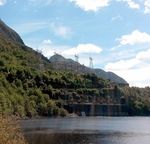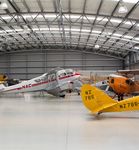THE FUTURE OF THE PAST KA MUA, KA MURI - Australasian Engineering Heritage Conference
←
→
Page content transcription
If your browser does not render page correctly, please read the page content below
THE FUTURE OF THE PAST Photo © Real Journeys KA MUA, KA MURI Australasian Engineering Heritage Conference PRE-CONFERENCE TOUR 11–14 NOVEMBER 2021
Join us for a three-day pre-conference
tour taking in the best of Otago and
Southland’s engineering heritage across
Queenstown, Milford Sound, the
South Coast and Invercargill.
PROUDLY SPONSORED BY
COST INCLUSIONS
• Accommodation for the nights of 11, 12 and 13 November
• Breakfast, lunch and dinner on 12 and 13 November
• Breakfast and lunch on the 12, 13 and 14 November
• Milford Sound cruise
• Entry to
• Templeton Flax Museum
• Bill Richardson Transport Museum
• Mandeville Aircraft Museum
• Croydon Aircraft Company Workshop
REGISTRATION
To register for this amazing experience visit
engineeringnz.org/heritage2021THURSDAY 11 NOVEMBER
Optional evening cruise on the TSS Earnslaw and dinner at Walter Peak Station
What's in store?
Cruise beautiful Lake Wakatipu on the 107-year-old TSS Earnslaw. The Earnslaw, powered by twin coal-fired triple-expansion
engines, is the only working coal-fired steamship on the Lloyd’s Register. Passengers can enjoy access to a walkway in the engine
room, where they can observe the operation of the engines and stokers.
Note: This is not included in the tour price. You will need to book directly with Real Journeys – enter promo code
AUSHERITAGECONF to receive a discounted price.
SCHEDULE
5.45pm Boarding (Queenstown)
6.45pm Arrive at Walter Peak Station for dinner in the Colonel’s Homestead Restaurant, followed by sheep shearing and working
sheepdog demonstrations.
10pm Return to Queenstown
Accommodation
Copthorne Resort HotelFRIDAY 12 NOVEMBER
Queenstown to Te Anau via Milford Sound
What's in store?
• Breakfast
• 7.30am Tour bus departs Queenstown
• Travel to Homer Tunnel, stopping at various sightseeing attractions along the way.
• At the Homer Tunnel, you'll hear a talk from NZ Transport Agency (NZTA) on the tunnel and the operational avalanche issues.
• Continue on to Milford Sound. View the 75-metre-long Tutoko Suspension Bridge, built in 1940 to cross the Tutoko River.
This helped complete the road to Milford Sound.
• Milford Sound Cruise: Experience a two-hour cruise travelling the length of the sound, with a picnic lunch included.
• 5pm Arrive Te Anau
• During dinner, enjoy a presentation about the Avalance Programme from an NZTA representative
Accommodation
Distinction Luxmore Hotel
Included meals
Breakfast, lunch and buffet dinner
The Homer Tunnel
The Te Anau to Milford Road was a Great Depression Relief Work project.
Work on the Homer Tunnel begun in 1935, with just five men working with
hand tools on the Te Anau Portal. The initial tunnel breakthrough was in 1940.
The project was then delayed by World War II. Work recommenced after the
war and the tunnel finally opened in 1954. The Tunnel is 1.2km long with a
10% gradient.
The Homer Tunnel was recognised as part of the IPENZ (Now Engineering
New Zealand) “Engineering to 1990” project, to celebrate the country’s
sesquicentenary in 1990. A plaque was unveiled to mark the significance of
the tunnel as part of the development of the nation.
The avalanche control programme in this area has been in development since
1983 and is now acknowledged as amongst the best in the world.SATURDAY 13 NOVEMBER
Te Anau to Invercargill
What's in store?
• Breakfast
• 8am Depart Te Anau
• View the Lake Te Anau and Lake Manapouri outlet structures – both part of the Manapouri Power Station complex.
• Continue on to a view of the Clifden Suspension Bridge
• Travel on to Riverton and the Templeton Flax Mill, where you'll see a short video of the flax industry, and a working
demonstration of the mill. Around 70 mills operated in Southland at one time – the Templeton Mill is the only operational
one left in the country. The Templeton family owned and operated a flax mill on this very site. In 2004, the family turned this
105-year-old mill into a working heritage museum.
• Travel to Invercargill for lunch and a tour of Bill Richardson Transport Museum – the largest private museum of its type in the
world an absolute must see for anyone with a passion for wheels. There are hundreds of motor vehicles and petrol pumps on
display throughout the 15,000m2 site.
• If motoring's not your thing, you might instead enjoy the growing wearable arts collection, movie theatre and themed
bathrooms.
• After the transport museum enjoy some free time. You might take this opportunity to visit the Classic Motorcycle Mecca,
the largest display of classic motorcycles in New Zealand. The Mecca includes solo, sidecar and three-wheeled vehicles
and machinery dating back to 1902. See over 60 manufacturers, with some astounding restorations, from a 1902 Peugeot
motorcycle to a 21st century Simms Corbin Custom.
Accommodation
Kelvin Hotel
Included meals
Breakfast, lunch and dinner
Manapouri Power Station
The Manapouri Power Station is an underground hydroelectric power station
on the western arm of Lake Manapouri. At 800 MW capacity it is the largest
hydroelectric power station in New Zealand.
Completed in 1971, Manapouri was built to supply electricity to the Tiwai Point
aluminium smelter near Bluff, some 160km to the southeast. The station
utilises the 230m drop between the western arm of Lake Manapouri and the
Deep Cove branch of Doubtful Sound 10km away, to generate electricity.
The construction of the station required the excavation of almost 1.4 million
tonnes of hard rock to build the machine hall and a 10km tailrace tunnel.
To increase the station’s capacity, a second parallel tailrace tunnel was
completed in 2002.
Clifden Suspension Bridge
Designed by C. H. Howarth and costing £5,007, the bridge was officially
opened by Sir Joseph Ward on 5 April 1899. It is a fine example of a
suspension bridge, representing a high standard of design and bridge
carpentry. Although modest by international standards, it is the longest
suspension bridge in New Zealand. The building of a bridge of this span was
a significant local engineering feat made possible by the tensile properties
of new steel cables. The Clifden Bridge has 27 of these steel cables attached
to concrete pillars (clad to resemble stone pillars) and still has its historic
wooden decking. It is a Heritage New Zealand Category I Historic Place.SUNDAY 14 NOVEMBER
Invercargill to Dunedin
What's in store Included meals
• Breakfast
Breakfast and lunch.
• 8am Depart Invercargill.
• Travel to Mandeville.
• Visit Croydon Aviation Centre, K92 Rogers Steam
locomotive, and Croydon Aircraft Company Workshop. If
we're lucky the K92 will be in steam at the time of our visit.
The Rogers K class locomotives arrived in New Zealand in
1879. The K92 was dumped in the Oreti River at Mararoa
in 1927, at the end of its useful life. In 1885, it was retrieved
from the river and subsequently restored. The Waimea
Plains Railway Trust hopes to have K92 running on a portion
of the Waimea Plains railway in the near future.
• Stop for lunch at the Mandevile Café.
• Continue on to theTuapeka Mouth Punt.
• Depart Tuapeka Mouth for Dunedin.
• 4pm arrive Dunedin.
Tuapeka Mouth Punt
The Tuapeka Mouth Punt is a rare surviving reaction cable ferry. A reaction
cable ferry uses the river current to push the punt across the river. Cables
guide the punt across the river from jetty to jetty.
Punts and ferries were among the earliest services provided for crossing
New Zealand’s wild rivers, and many settlements were built around crossing
places. The Clutha River was a particularly formidable barrier and many punts
and ferries criss-crossed the fast-flowing current from the 1850s onwards.
In the 1890s, residents successfully petitioned the Tuapeka County Council
for a public punt at Tuapeka Mouth. The service officially opened on
22 February 1896. Initial rates were 6d for passengers and horses, with
a sliding scale for various numbers of sheep, and 3d a head for cattle.
The Tuapeka Mouth Ferry and Jetty Site is of special significance as the sole
remnant of what was once a network of punt sites up and down the Clutha/
Mata-Au River in Otago and it is now the only punt site still in operation in
New Zealand.
Croyden Aviation Heritage Centre
Relive the golden age of flight at one of New Zealand’s hidden gems – the
Croyden Aviation Heritage Centre in Mandeville, Southland. This nationally
significant museum is dedicated to preserving and celebrating New Zealand’s
civil aviation heritage – both the stories of pioneer aviators and their equally
colourful machines.
See a wide range of fully restored aircraft, most of which are from the 1920s
and 1930s – including the largest collection of de Havilland aircraft in the
southern hemisphere. The collection is unique in that nearly all of the aircraft
on display can actually fly.
Many of the aircraft on display have been restored by the Croydon Aircraft
Company, who specialise in the restoration of de Havilland and other vintage
aircraft. And best of all, we've arranged for you to view the workshop.Photo acknowledgements • Cover: Real Journeys • Queenstown: Samuel Ferarra/Unsplash • Bill Richardson Transport Museum: John Welsh • TSS Earnslaw: Stephen Crowley/Unsplash • Homer Tunner: Nigel Hoult • Milford Sound: Jasper van der Meij/Unsplash • Milford Sound cruise: Bernard Spragg • Manapouri Power Station: Angeli Winthrop • Clifden Suspension Bridge: Harold Selke • Tuapeka Mouth Punt: GuyroGrandad/Wikimedia • Croyden Aviation Heritage Centre: Oren Rozen/Wikimedia
Australasian Engineering Heritage Conference ehconference@engineeringnz.org engineeringnz.org/heritage2021
You can also read



























































